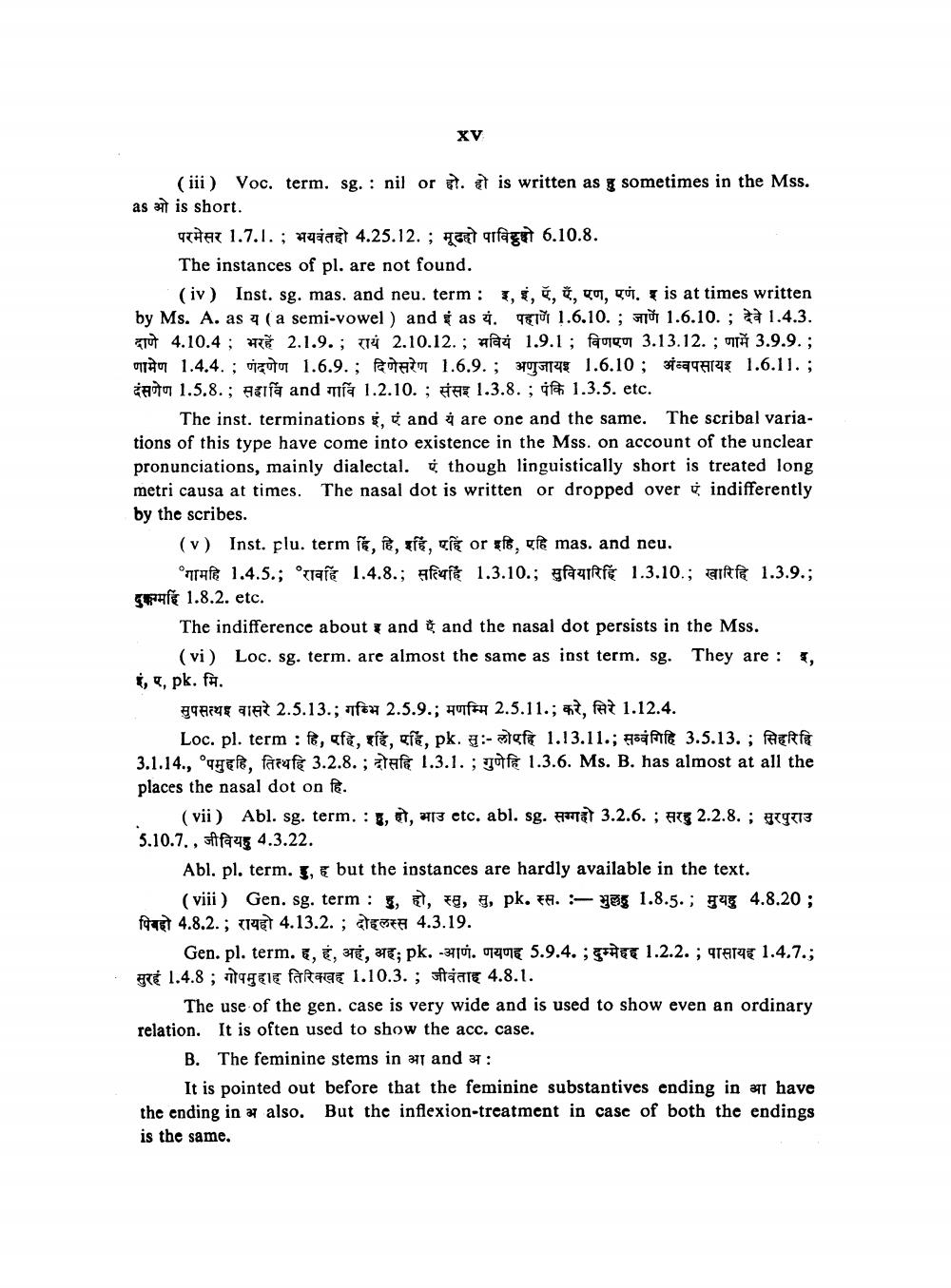________________
XV
(iii) Voc. term. sg.: nil or . t is written as g sometimes in the Mss. as a is short.
परमेसर 1.7.1.; भयवंतदो 4.25.12.; मूढहो पावो 6.10.8.
The instances of pl. are not found.
(iv) Inst. sg. mas. and neu. term:,,,,, . is at times written by Ms. A. as य ( a semi-vowel ) and as यं. पहाणें 1.6.10.; जाणें 1.6.10.; देवे 1.4.3. दाणे 4.10.4; भरहें 2.1.9; रायं 2.10.12; भवियं 1.9.1; विणएण 3.13.12. ; णामें 3.9.9. ; णामेण 1.4.4. णंदणेण 1.6.9 दिणेसरेग 1.6.9; अणुजायर 1.6.10 अय्यपसायर 1.6.11. दंसणेण 1.5.8; सहाविं and गाविं 1.2.10. ; संसर 1.3.8. ; पंकि 1.3.5. etc.
The inst. terminations, and are one and the same. The scribal variations of this type have come into existence in the Mss. on account of the unclear pronunciations, mainly dialectal. though linguistically short is treated long metri causa at times. The nasal dot is written or dropped over indifferently by the scribes.
(v) Inst. plu. term fe,, f, or fe, fe mas. and neu.
"गामहि 1.4.5. रावदि 1.4.8. सत्विह 1.3.10. सुनिवारिधि 1.3.10 खारिहि 1.3.9.; दुकम्महिं 1.8.2. etc.
The indifference about and and the nasal dot persists in the Mss.
(vi) Loc. sg. term. are almost the same as inst term. sg. They are : ༣, , pk. मि.
सुपसत्थर वासरे 2.5.13.; गम्भि 2.5.9.; मणम्मि 2.5.11.; करे, सिरे 1.12.4.
Loc. pl. term : हि रहि रहि रहि, pk :- लोएहि 1.13.11.; सम्बंगिहि 3.5.13. सिरिद्धि 3.1.14., मुहहि तित्थहि 3.2.8. ; दोसहि 1.3.1.; गुणेहि 1.3.6. Ms. B. has almost at all the places the nasal dot on f.
"
(vii) Abl. sg. term. : टु, हो, भाउ etc. abl. sg. सग्गहो 3.2.6; सरहु 2.2.8. ; सुरपुराउ 5.10.7 जीवियहु 4.3.22.
Abl. pl. term. I, but the instances are hardly available in the text.
(viii) Gen. sg. term:,, a, a, pk. a. —
विहो 4. 8.2. रायहो 4. 13.2. दोलस 4.3.19.
1.8.5.; 4.8.20;
Gen. pl. term. छ, हं, अहं, अह; pk. आणं. णयणह 5.9.4. ; दुम्मेद्दह 1.2.2. ; पास यह 1.4.7.; सुर 1.4.8 गोवा तिरिमल 1.10.3. जीता 4.8.1.
The use of the gen. case is very wide and is used to show even an ordinary relation. It is often used to show the acc. case.
B. The feminine stems in a and
It is pointed out before that the feminine substantives ending in a have the ending in a also. But the inflexion-treatment in case of both the endings is the same.




